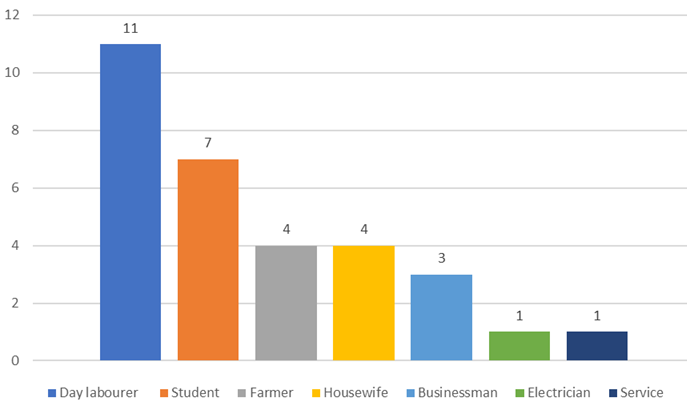Surgical Outcome of Short Segment Instrumentation including Fracture Vertebrae of Thoracolumbar Burst Fracture
Abstract
Background: Fractures of the thoracolumbar region are the most common injuries of the spine; among them burst fractures are the most frequent. Several studies were done to see the surgical outcome in thoracolumbar burst fracture hence surgery was recommended for better outcome. So, the current study was aimed to evaluate the clinical, functional and radiological outcome of short-segment pedicle screw fixation including the fractured vertebral body. Objectives: The aim of the study was to evaluate the surgical outcome of short segment pedicle screw fixation including fracture vertebrae of unstable thoracolumbar burst fracture with incomplete spinal cord injury. Methods: In this prospective observational study, a total of 62 cases were studied from May 2019 to May 2021 through non randomized purposive sampling. All the patients were between 15 to 60 years of age and operated within 21 days of fracture by posterior decompression & stabilization by short-segment pedicle screw fixation including the fractured vertebral body. Postoperative functional outcome was assessed clinically by ASIA, ODI, VAS, Denis Work Scale, Macnab criteria and radiologically by Cob’s kyphotic angle, kyphotic deformation, Beck index & Bridwell criteria. Postoperative follow up was conducted at 6th, 12th & 24th weeks. Statistical analyses of the results were be obtained by using window-based Microsoft Excel and Statistical Packages for Social Sciences (SPSS-24). Results: The mean age was 31.42±11.2 years with male dominancy (74.19%). Most of the cases were manual workers (51.61%). FFH was the most common cause of injury (80.65%) and L1 was the most common level of injury (54.84%). The mean duration between injury and operation time was 14.45±3.72 days. Regarding improvement of ASIA grade, 1 grade in 46 (74.19%) cases, 2 grade in 2 (3.23%) case, no improvement in 14 (22.58%) cases were seen. Complications were hemorrhage 2(3.23%), dural tear 2(3.23%), CSF leak 2(3.23%), urinary retention 4(6.45%), skin infection 2(3.23%) and bed sore 2(3.23%). Conclusion: Thoracolumbar burst fracture with incomplete spinal cord injury can be treated with short-segment pedicle screw fixation including the fractured vertebral body effectively. This method offered a better kyphosis correction, no instrument failures, appraisable clinical and functional recovery, reduce pain and improve working status with early rehabilitation.
Downloads
References
Wood KB, Bohn D, Mehbod A. Anterior versus posterior treatment of stable thoracolumbar burst fractures without neurologic deficit: a prospective, randomized study. Clinical Spine Surgery. 2005 Feb 1;18: S15-23.
Green DP. Rockwood and Green's fractures in adults. Lippincott Williams & Wilkins; 2010.
Schweitzer KM, Vaccaro AR, Harrop JS, Hurlbert J, Carrino JA, Rechtine GR, Schwartz DG, Alanay A, Sharma DK, Anderson DG, Lee JY. Interrater reliability of identifying indicators of posterior ligamentous complex disruption when plain films are indeterminate in thoracolumbar injuries. Journal of Orthopaedic Science. 2007 Sep; 12:437-42.
HOLDSWORTH F. Review article fractures, dislocations, and fracture-dislocations of the spine. JBJS. 1970 Dec 1;52(8):1534-51.
Denis F. The three-column spine and its significance in the classification of acute thoracolumbar spinal injuries. spine. 1983 Nov 1;8(8):817-31.
Tian NF, Wu YS, Zhang XL, Wu XL, Chi YL, Mao FM. Fusion versus nonfusion for surgically treated thoracolumbar burst fractures: a meta-analysis. PloS one. 2013 May 21;8(5): e63995.
Formica M, Cavagnaro L, Basso M, Zanirato A, Felli L, Formica C, Di Martino A. Which patients risk segmental kyphosis after short segment thoracolumbar fracture fixation with intermediate screws? Injury. 2016 Oct 1;47: S29-34.
Altay M, Ozkurt B, Aktekin CN, Ozturk AM, Dogan Ö, Tabak AY. Treatment of unstable thoracolumbar junction burst fractures with short-or long-segment posterior fixation in magerl type a fracture. European Spine Journal. 2007 Aug; 16:1145-55.
Shao X, Peng P, Yang P, Xu T, Liu Z, Hua X, Zhu X, Qian Z, Yang H, Mao H, Chen K. A retrospective comparative study of clinical efficacy of percutaneous short segment pedicle screw fixation with or without screwing of the fractured vertebra with O-arm navigation. BMC Musculoskeletal Disorders. 2022 Feb 1;23(1):108.
Raja RA. Management of thoracolumbar spine injuries at a tertiary care hospital. Journal of Ayub Medical College Abbottabad. 2010 Mar 1;22(1):171-5.
Katonis PG, Kontakis GM, Loupasis GA, Aligizakis AC, Christoforakis JI, Velivassakis EG. Treatment of unstable thoracolumbar and lumbar spine injuries using Cotrel–Dubousset instrumentation. Spine. 1999 Nov 15;24(22):2352.
Ahsan MK, Zahangiri Z, Awwal MA, Zaman N, Haque MH, Al Mahmud A. Posterior fixation including the fractured vertebra in short segment fixation of unstable thoracolumbar junction burst fractures. Bangabandhu Sheikh Mujib Medical University Journal. 2016 Aug 17;9(2):81-7.
Lee GW, Jang SJ, Kim JD, Son JH, Jang JH. The efficacy of percutaneous long-segmental posterior fixation of unstable thoracolumbar fracture with partial neurologic deficit. Asian spine journal. 2013 Jun;7(2):81.
Payer M. Implantation of a distractible titanium cage after cervical corpectomy: technical experience in 20 consecutive cases. Acta neurochirurgica. 2006 Nov; 148:1173-80.
Muralidhar BM, Hegde D, Hussain PS. Management of unstable thoracolumbar spinal fractures by pedicle screws and rods fixation. Journal of Clinical and Diagnostic Research: JCDR. 2014 Feb;8(2):121.
Kirshblum SC, Burns SP, Biering-Sorensen F, Donovan W, Graves DE, Jha A, Johansen M, Jones L, Krassioukov A, Mulcahey MJ, Schmidt-Read M. International standards for neurological classification of spinal cord injury (revised 2011). The journal of spinal cord medicine. 2011 Nov 1;34(6):535-46.
Defino HL, Scarparo P. Fractures of thoracolumbar spine: monosegmental fixation. Injury. 2005 Jul 1;36(2): S90-7.
Alanay A, Acaroglu E, Yazici M, Oznur A, Surat A. Short-segment pedicle instrumentation of thoracolumbar burst fractures: does transpedicular intracorporeal grafting prevent early failure?



























